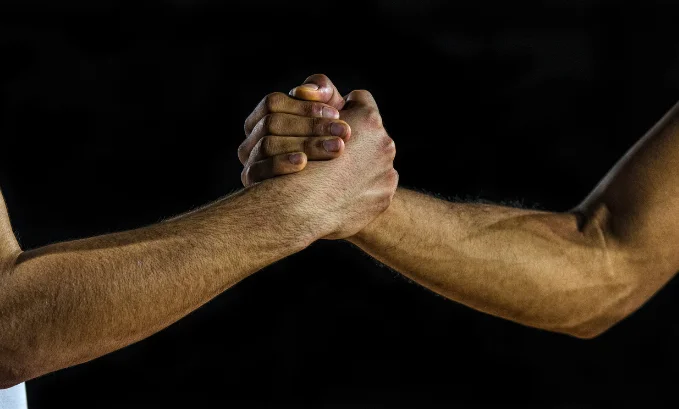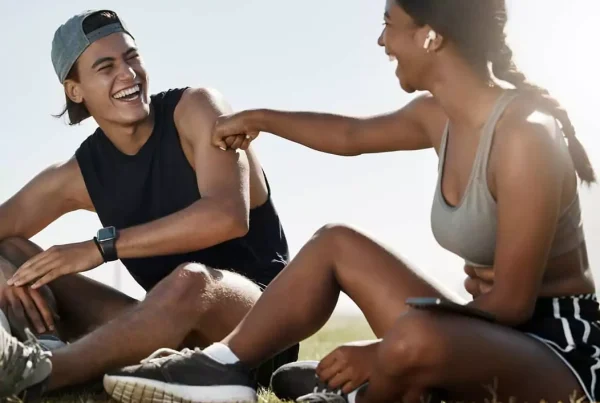Today’s topic is Managing Interpersonal Relationships! On Sundays, we strive to provide information that you can use to better relationships with your friends, family, and significant others alike! Today’s subject is the king of impressionability – the handshake. A handshake is more than just a simple gesture of greeting, it’s a powerful tool for communication and creating a positive first impression. After all, who pays mind to a person with a limp handshake – am I right? But have you ever stopped to think about the psychology behind the handshake? Why is it so important in western culture? Why do other countries avoid it all together? Well, let’s find out and explore the importance of this age-old tradition.
First, let’s talk about the power of touch. Studies have shown that physical touch can convey a range of emotions and intentions, from aggression to affection (Hertenstein, et al. 2009). A firm handshake can convey confidence, assertiveness, and dominance, while a weak handshake can convey submissiveness and anxiety. But it’s not just the strength of the handshake that matters, the duration of the handshake and the level of eye contact can also convey important information about the person you’re interacting with. Interpersonal communication theory also gives us insight into the importance of nonverbal cues like the handshake. According to the “Social Penetration Theory” (Altman & Taylor, 1973), nonverbal cues like the handshake can be used to gauge a person’s level of trust and intimacy. A firm handshake and direct eye contact can indicate that a person is open and confident, while a weak handshake and averted gaze can indicate that a person is closed off or guarded. So, it is best to lead with confidence.
Western culture has adopted the handshake as a universal form of greeting. Given Europe’s heavy past influence in the west, particularly in the colonial United States, the handshake has been passed down and has become an integral part of many cultures. The United States has a history of being a melting pot of cultures, many of which are burdened with communication barriers. Because the handshake is a simple, nonverbal gesture, it is easy for people of different backgrounds to understand and use. The United States also has a strongly individualistic culture, where people value self-reliance and independence. The handshake is a way to show that one is self-assured and confident. In this sense, it can be seen as a symbol of equality, as it indicates that two people are on the same level and greeting each other as equals. This is especially important in a business (formal) setting, as it conveys trustworthiness between cooperating parties.
However, in some Asian cultures, physical contact is viewed differently than in Western cultures, and handshakes may not be as common as a form of greeting. For example, in countries like Japan and Korea, bowing is the traditional form of greeting and is considered more appropriate in formal situations. Bowing is a way to show respect and humility, which are important values in many Asian cultures. Additionally, some cultures may view handshakes as less hygienic and prefer to avoid physical contact; people maintain a certain level of distance and reserve in social interactions, as handshakes can be seen as too intimate. In my experiences living in Korea, the lack of physical interaction was slightly alarming.
As an American, I’ve always gauged impressionability by the firmness of one’s handshake – like I said, who likes a limp handshake? But I’ve come to understand why it is less socially acceptable; the biggest reason being that a handshake assumes you’re greeting as equals. Many Asian cultures, like Korea, utilize honorifics. Honorifics are words or titles used to show respect and indicate a person’s social status, much of which is predicated upon age. Greeting your senior, or your boss as an equal through the use of a handshake is considered disrespectful, as you are expected to be humble in their presence – hence the use of a deep bow instead. This is not to say don’t shake peoples’ hands, it’s to remind you to be aware of the cultural implications of something as simple as a touch of the hand!
So, how can you improve your handshake and other impressionable gestures?
Here are a few tips:
• Make sure your handshake is firm, but not crushing. You want to convey confidence and assertiveness, but not come across as aggressive or domineering.
• Maintain eye contact during the handshake. This shows that you’re engaged and interested in the other person.
• Pay attention to the duration of the handshake. A quick, perfunctory handshake can convey disinterest, while a lingering handshake can be seen as overbearing.
• Be mindful of your body language. Stand up straight, make open, confident gestures, and be aware of any nervous habits (like fidgeting or avoiding eye contact) that might undermine your confidence.
But let’s not forget the fun side of handshakes. You can always spice it up with a secret handshake with your friends or family, or even come up with a new and creative one for each new person you meet. You can make it a high-five, a fist bump, or even a dance move.
The possibilities are endless! The handshake is a simple but powerful tool for making a good impression and communicating effectively with others. In being aware of the psychological and cultural implications of the handshake, and by taking steps to improve your own handshake and other nonverbal cues, you can make a great first impression and build stronger relationships with the people around you. Until next time…
Ryan Alvarez
References:
- Gibson, J.J., et al. (2016). The handshake in social interaction. Personality and Social Psychology Review, 20(1), 71-91.
- Altman, I., & Taylor, D.A. (1973). Social penetration: The development of interpersonal relationships. New York, NY: Holt, Rinehart, and Winston.
- Hertenstein, J.J., et al. (2009). The communicative functions of touch in humans, evolution, and development. Communicative & Integrative Biology, 2(5), 408-417.






